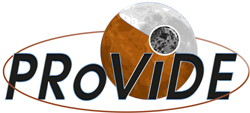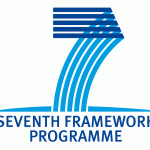PRoViDE Plenary Exploitation Event Dec 2nd at VRVis GmbH, Techgate, Vienna/Austria
13:30 PRoViDE 3D vision processing & fusion from planetary rover’s images
Gerhard Paar, JOANNEUM RESEARCH, AT
13:50 Mosaics from Mars: Rover Panorama Production and Use
Bob Deen, Multimission Image Processing Laboratory, Jet Propulsion Laboratory, California Institute of Technology, USA
14:30 Filling the visual gap between rover cameras and orbital views using superresolution restoration
Jan Peter Muller, Mullard Space Science Laboratory, University College, London, UK
14:50 MSL Curiosity rover geologic exploration on Mars
Sanjeev Gupta, Imperial College London, UK
15:10 3D Geologic Analysis of Planetary Surfaces Using PRo3D
Rob Barnes, London, UK / Christoph Traxler, VRVis, AT
15:30 Demos
PRoGIS: Contextualising and Analysing Planetary Rover Image Products
Michele Giordano, University of Nottingham, UK
Lunar GIS Portal: Context on the Surface of Moon in 2D and 3D
Andrey Garov, MIIGAiK, RU
PRo3D: A Virtual Environment for the Accurate Geologic Analysis of Martian Terrain
Christoph Traxler, VRVis, AT
16:30 Discussion
Special Lecture on Planetary Science – VIENNA July 15th 2015
Leading scientists in the field of planetary science will give special lectures on their research work. They will explain how imagery from orbiters and rovers are processed and used for scientific analysis.
| When: | Wednesday, July 15th 2015, 13:30-15:00 |
| Where: | Tech Gate Vienna, Business Stage 4.2, Donau-City-Strasse 1,4th Floor, 1220 Wien |
leaflet: PRVD-Planetary Science Lecture Announcement-July15-2015-VRVis
Public Session at Arizona State University April 22, 2015 01.00-05.00 pm
The Auditorium (ISTB4, Room 240) Arizona State University (ASU)
(ISTB4 building located at 781 E Terrace Mall, Tempe, AZ 85287)
13.00-17.00/ 01.00 -05.00 pm
Leading European scientists & engineers in the field of planetary robotics vision will give short lectures on their research work in the fields of 3D vision processing, GIS and visualization, targeted to the European ExoMars Rover Mission, embedded in work funded by the European Union’s research Framework Programme 7.
The EU FP7 Project PRoViDE: 3D vision processing from planetary rovers’ imagers Gerhard Paar, JOANNEUM RESEARCH, Graz, Austria
A spatial data base for representing planetary images in the context of processing Konrad Willner, German Aerospace Center, Berlin, Germany
Serendipitous Multi-view Stereo: 3D reconstruction of planetary sites from multiple viewpoints Tomas Pajdla Czech Techniqual University of Prague, Czech Republic
Processing of Lunar Surface Image Data Ender Tasdelen, Technical University Berlin, Germany
Fusing ground-level with super-resolution orbital views of Mars for visualization and Rover localization Jan-Peter Muller & Yu Tao, Mullard Space Science Laboratory, University College London
Contextualising and Analysing Planetary Rover Image Products through the Web-Based PRoGIS Michele Giordano, Jeremy Morley, Nottingham Geospatial Institute, University of Nottingham, Nottingham, UK
PRo3D: A Virtual Environment for the Accurate Geologic Analysis of Martian Terrain Christoph Traxler, VRVis Forschungs GmbH, Vienna, Austria
Geological Interpretation and Analysis of Surface Based, Spatially Referenced 2.0 and PRo3D Rob Barnes, Sanjeev Gupta, Imperial College London, United Kingdom
Public Session at Jet Propulsion Laboratory April 20th, 2015
Monday, April 20, 2015, 3:00 – 4:30 pm,
JPL Conference Room 180-101
Jet Propulsion Laboratory, Pasadena
Leading European scientists & engineers in the field of planetary robotics vision will give talks on their Research results in the fields of 3D vision processing, GIS and visualization, targeted to the European ExoMars Rover 2018 Mission, embedded in work funded by the European Union’s research 7 Framework Programme.
www.provide-space.eu The EU FP7 Project PRoViDE: 3D vision processing from planetary rovers’ imagers & their visualization
Gerhard Paar/ JOANNEUM RESEARCH, Graz, Austria Christoph Traxler/VRVis, Vienna, Austria
Fusing ground-level with super-resolution orbital views of Mars for visualization and Rover localization
Jan-Peter Muller & Yu Tao, Mullard Space Science Laboratory, University College London, UK
Contextualising and Analysing Planetary Rover Image Products through the Web-Based PRoGIS
Michele Giordano, Jeremy Morley Nottingham Geospatial Institute, University of Nottingham, Nottingham, UK
PhD High-quality Stereo Matching Strategies for Planetary Rover Imagery
NEW: open PhD 2015 – 2017
High-quality Stereo Matching Strategies for Planetary Rover Imagery
The European ExoMars Rover (To be launched to Mars in 2018 with foreseen landing in 2019) will contain a panoramic camera system (PanCam) that is used for stereoscopic 3D reconstruction of the Rover environment. JR is coordinating the PanCam 3D vision processing, in this role the stereo matching from PanCam images (between left and right wide angle camera – WAC, as well as between one of the WACs and the High Resolution Camera – HRC having different focal lengths) is being implemented in the 3D vision chain of rover image ground processing. To gain maximum scientific output from the 3D vision processing, to geologically map the Rover’s environment in 3D, highest quality and robustness of the used matching methods is essential
POSTER at AGU 2014
PRoViDE Poster presentation in December at AGU 2014:
New Video – The Journey of Lunokhod 1
The video shows the journey of the Lunokhod-1 on the lunar surface. The unmanned interplanetary mission Luna 17 was launched to the Moon on 10 November 1970. The spacecraft successfully landed in the Sea of Rains on 17 November 1970 and the first automatic lunar rover Lunokhod-1 was deployed to the surface. During the operation (until Sept 1971) Lunokhod-1 sent to the Earth about 200 lunar panoramas and approximately 25,000 navigation images. Lunokhod-1 was detected on Lunar Reconaissance (LRO) Narrow Angle Camera (NAC) images in March 2010.
The digitized route is based on the true path of the Lunokhod-1 recognized on high-resolution LRO NAC images of the Moon. The traverse was identified and digitized manually at MExLab (MIIGAiK Extraterrestrial Laboratory, http://mexlab.miigaik.ru/eng/).
A detailed model of the rover Lunokhod-1 was created at MExLab in 3Ds Max™ based on published parameters and description of its construction. The NAC Digital Terrain Model (DTM) and ortho image, which were used for lunar surface modeling, were provided by DLR. The animation was created in Scanex Image Processor™.
Lunokhod is shown in real scale w.r.t. the landscape.
The research leading to these results has received funding from the European Community’s Seventh Framework Programme (FP7/2007-2013) under grant agreement n° 312377 ProViDE.
Video on YouTube:
PRoViDE Poster at 8th International Conference on Mars
Imperial College London: Research Associate in Planetary Surface Processes
Imperial College London
Department of Earth Science and Engineering
Research Associate in Planetary Surface Processes
Fixed term appointment for up to 11months
Salary range £33,410 – £42,380 per annum*
Maximum starting salary on appointment is £38,100 per annum – appointments are ormally made at the bottom of the salary scale
Applications are invited for a Research Associate in Planetary Surface Processes ith a focus on candidates with experience in field-based clastic sedimentology and tratigraphy and/or analysis of Mars rover-derived geological datasets. The project is unded by the European Union Framework 7 Space Science Programme within the RoViDE (Planetary Robotics Vision Data Exploitation; http://www.provide-space.eu) project.
The position is based at the Department of Earth Science and Engineering at Imperial College London, but involves collaboration with multiple institutes. The position is a fixed term appointment available for up to 11 months and is available to start as soon as possible.
The PRoViDE FP7 project is assembling a major portion of the imaging data gathered so far from planetary surface robots into a unique database, bringing them into a spatial context and providing access to a complete set of 3D vision products.The focus of this project is to conduct geological analysis of several use cases utilizing PRoViDE. We require a researcher with either field-based terrestrial geological experience or rover-based analysis experience to work with the PRoViDE team in exploring and helping to streamline tools developed by PRoViDE for geological analysis of planetary surface datasets, and to conduct scientific studies of use case examples. The Research Associate will characterize the geology of use case study sites employing a combination of orbital image and rover-derived Image analysis, and employing novel web-GIS and visualization systems. The successful candidate will have a background in planetary or earth surface processes, planetary geology, sedimentology and stratigraphy. Skills in geographic information systems and satellite image analysis are prerequisite. A PhD (or equivalent) in a relevant subject is required. Geological field experience particularly in sedimentology and stratigraphy will be advantageous. Experience in analysis of orbital or rover-derived imagery is also of value.
You will work in the Earth & Planets Section of the Department of Earth Science and Engineering. The work will be carried out in collaboration with expertise in robotics, imaging, web-GIS development and visualization.
Further information can be obtained from Professor Sanjeev Gupta, s.gupta@imperial.ac.uk.
This post will be based at the South Kensington Campus. Our preferred method of application is online via our website. Please go below or go to
http://www3.imperial.ac.uk/employment.
Select “Job Search” then enter the job title or vacancy reference number into “Keywords”). Please complete and upload an application form as directed quoting reference number EN20140378FH.
Further information is also available on the job description. Further guidance may be sought from Mrs Darakshan Khan d.khan@imperial.ac.uk.
*Candidates who have not yet been officially awarded their PhD will be appointed as Research Assistant within the salary range £29,350 – £32,520 per annum
Closing Date: 30 November 2014
Imperial Managers lead by example. Committed to equality and valuing diversity. We are also an Athena SWAN Silver Award winner, a Stonewall Diversity Champion, a Two Ticks Employer, and are working in partnership with GIRES to promote respect for trans people





